day1
通过在每个HTML文档中放置一个<link>元素,可以将外部CSS样式表应用于任意数量的HTML文档。<link>标记的属性rel必须设置为“样式表”,而href属性必须设置为指向样式表的相对路径或绝对路径。虽然使用相对URL路径通常被认为是良好的做法,但也可以使用绝对路径。在HTML5中,可以省略类型属性。建议将<link>标记放<head>里面
<!DOCTYPE html> <html> <head> <link rel="stylesheet" type="text/css" href="style.css"> <meta charset="UTF-8"> <title>Title</title> <style> p{font-size: 20px; color:red;} h1{color: blueviolet; font-family: "Arial Narrow"; } </style> </head> <body> <h1 style="color: green; text-decoration: underline;">hello world</h1>//实践证明此处对颜色的控制强于在head里面<style>对颜色的设置 <p style="font-size: 25px;font-family: 'Trebuchet MS';">啧啧啧</p> <script> console.log("hello,world!"); console.log("啊呀"); </script> </body>
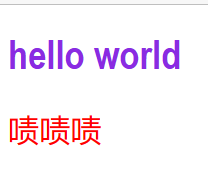

一、Structure and Formatting of a CSS Rule——CSS规则的结构和格式化
1、Property Lists ——属性列表
可以写在一行,也可以分开写。
2、multiple selectors
对css选择器进行分组是,可以将相同的样式应用到几个不用的元素,二不重复样式表中的样式,用逗号来隔开。
3、一些基础的选择器
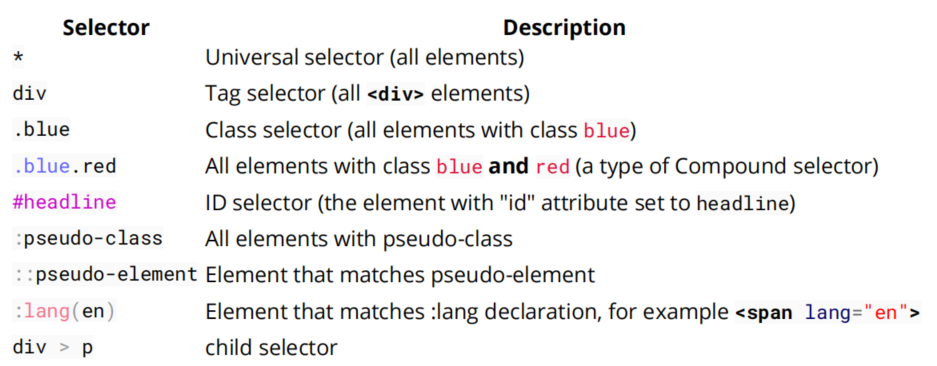
选择具有给定属性和值的元素,其中给定属性在任何位置都包含给定值(作为子字符串)
1、[attribute]
div[data-color] { color: red; } <div data-color="red">This will be red</div> <div data-color="green">This will be red</div> <div data-background="red">This will NOT be red</div>
2、[attribute="value"]
div[data-color="red"] { color: red; } <div data-color="red">This will be red</div> <div data-color="green">This will NOT be red</div> <div data-color="blue">This will NOT be red</div>
3、[attribute*="value"]
<head> <meta charset="UTF-8"> <style> [class*="foo"] { color: red; } [class*="doo"] { color: black; } </style> </head> <body> <div class="foo-123">This will be red</div> <div class="doo-122">This will be what color</div> </body>
4、[attribute~="value"]
[class~="color-red"] { color: red; } <div class="color-red foo-bar the-div">This will be red</div> <div class="color-blue foo-bar the-div">This will NOT be red</div>
5、[attribute^="value"]
[class^="foo-"] { color: red; } <div class="foo-123">This will be red</div> <div class="foo-234">This will be red</div> <div class="bar-123">This will NOT be red</div>
6、[attribute$="value"]
[class$="file"] { color: red; } <div class="foobar-file">This will be red</div> <div class="foobar-file">This will be red</div> <div class="foobar-input">This will NOT be red</div>
7、[attribute|="value"]
[lang|="EN"] { color: red; } <div lang="EN-us">This will be red</div> <div lang="EN-gb">This will be red</div> <div lang="PT-pt">This will NOT be red</div>
8、[attribute="value" i]
[lang="EN" i] { color: red; } <div lang="EN">This will be red</div> <div lang="en">This will be red</div> <div lang="PT">This will NOT be red</div>
二、组合器
代码:
<head> <meta charset="UTF-8"> <style> div p { color: red; } </style> </head> <body> <div> <p>it will be red</p> <section> <p>it will be red</p> </section> </div> <p>it will be not red</p> </body>
注意,此处在style里面有写到div p,针对的是div里面的p.如果不在div里面就不会被约束,同样,如果在div中不是p段落,也不会被约束,变成红色。
如果style里面写的是div > p,那么只有被div直接包含的第一层会被约束颜色变为红色
如果想让相邻的段落变颜色,只需要后面加上+。例如p + p,但是如果p和p中间有其他的标签,就不会被约束到。
实践证明。当你想让body里面的哪个段落字体变颜色,只需要在style里面具体到他被包括的前面一个<>就可以了。俩个就可以具体到指定的位置,如果有相同的则需要在加一个
实现:
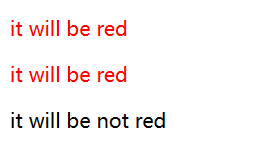
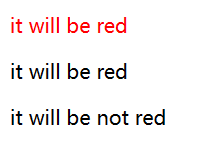
2、类名称选择器
代码:
例如想让下面段落的颜色变为蓝色。
<head> <meta charset="UTF-8"> <style> .important { color: orange; } .warning { color: blue; } .warning.important { color: red; } </style> </head> <body> <div class="warning"> <p>This would be some warning copy.</p> </div> <div class="important warning"> <p class="important">This is some really important warning copy.</p> </div> </body>
可以直接在<head>里面的<style>里面写
.warning { color: blue; } //也可以这样 div[clss = "warning"] { color:blue }

3、Select element using its ID without the high specifificity of the ID selector——使用其ID来选择元素,而没有ID选择器的高特异性
代码:
html
<div id="element">warning</div>
CSS
[id="element"] {color:black}//特异性低,易于覆盖 #element { color:red} //高特异性将覆盖许多选择器
实现:

4、最后一个类型的选择器
代码:
<head> <meta charset="UTF-8"> <style> p:last-of-type { background:#C5CAE9; } h1:last-of-type{ background: #cddc39; } </style> </head> <body> <div class="container"> <p>First paragraph</p> <p>Second paragraph</p> <p>Last paragraph</p> <h1>Heading 1</h1> <h2>First heading 2</h2> <h2>Last heading 2</h2> </div> </body>
实现:
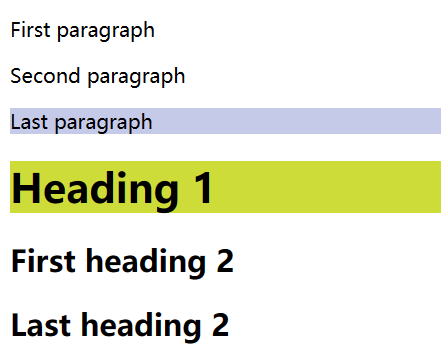
4、in-range 选择器
代码:
<head> <meta charset="UTF-8"> <style> input:in-range { border: 1px solid blue; } </style> </head> <body> <input type="number" min="10" max="20" value="15"> <p>The border for this value will be blue</p> </body>
实现:

5、CSS中的伪类的焦点
代码:
<head> <meta charset="UTF-8"> <style> div { height: 80px; } input { margin: 30px; } div:focus-within { background-color: #1565C0; } </style> </head> <body> <h3>Background is blue if the input is focused .</p> <div> <input type="text"> </div> </body>
实现:




 浙公网安备 33010602011771号
浙公网安备 33010602011771号